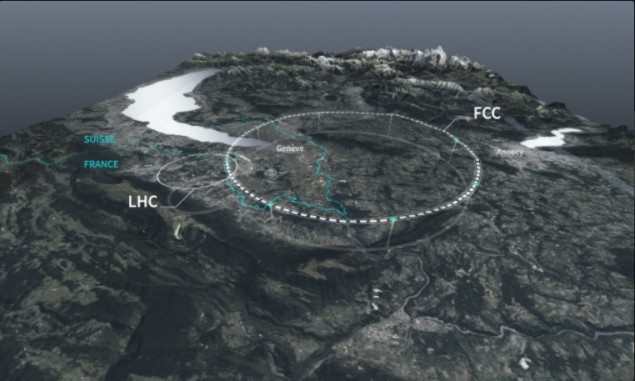CERN physicists meet in London to plot future collider plans
08 Jun 2023 Michael Banks
One ring: The Future Circular Collider, if built, would be a 90 km-circumference particle collider constructed in France and Switzerland (courtesy: D. Dominguez/CERN)
Hundreds of physicists met in London this week for the ninth Future Circular Collider (FCC) Conference. Held at the Millennium Gloucester Hotel London in South Kensington, the five days of talks focused on the latest developments on the FCC – a huge proposed particle collider that would succeed CERN’s Large Hadron Collider (LHC). If built, the collider would cost around £20bn and involve the construction of a 100 km underground tunnel at the current CERN site to house an electron–positron collider (FCC-ee).
Supporters hope that construction would begin in the early 2030s and last just over a decade, with the FCC-ee complete in 2045. The FCC-ee would focus on creating a million Higgs particles in total to allow physicists to study its properties with an accuracy an order of magnitude better that what is possible today with the LHC.
Once the physics programme for the FCC-ee is complete, estimated in 2063, the same tunnel could then be used to house a proton–proton collider, dubbed FCC-hh. The FCC-hh, which would begin operation in the 2070s, would use the LHC and its pre-injector accelerators to feed the collider that could reach a top energy of 100 TeV – seven times greater than the LHC.
CERN originally released a four-volume conceptual design report for the FCC in early 2019, while the following year CERN Council approved a feasibility study and a more detailed costing of the FCC. It also gave a green light to continued research and development into the magnet technology that will be required for such a machine at higher energies.
Make it so
This week’s meeting saw experts from academia and industry review the latest progress on the FCC and set the goals for the coming years. In a plenary address on Monday, CERN director-general Fabiola Gianotti confirmed the current schedule is on track. “I believe FCC is the best project for CERN’s future,” noted Gianotti. “We need to work together to make it happen.”
If given the green light, construction could begin in 2033 and occur in parallel with the operation of a major £1.1bn “high luminosity” upgrade of the LHC – dubbed HL-LHC – that will increase the collider’s luminosity by a factor of 10 over the original LHC. HL-LHC, which will begin operation in 2029, is set to finish it work in the early 2040s.
Michael Benedikt and Frank Zimmermann from CERN gave an update on the feasibility study, which involves hundreds of physicists based in 150 institutes spread over 34 countries.READ MORE

Physicists and engineers have been working on the optimization of the ring placement layout, choosing between about 100 different variations based on geology, land availability, access to roads as well as infrastructure needs such as water, electricity and transport.
They found the “lowest risk” option was a 90.7 km ring, allowing the FCC to have two or four collision points. Access to the tunnel is being reduced from 12 points in the conceptual design report to eight in the feasibility study. In February, engineers began environmental studies and the preparation of geological investigations based on this blueprint.
A mid-term review of the feasibility study is expected to be complete later this year and in February 2024, the CERN Council will hold a special meeting to analyse the study’s progress as well as an updated costing for the facility.
The feasibility study for the FCC is expected to be complete in 2025 with possible CERN approval for the project three years later. A final decision would, though, depend on the outcome of an update to the European Strategy for Particle Physics in 2026.
from physicsworld.com 9/6/2023

Δεν υπάρχουν σχόλια:
Δημοσίευση σχολίου